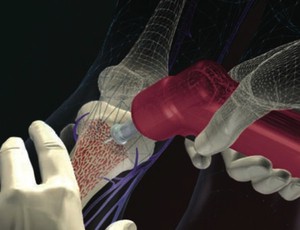Intraosseous infusion technique explained

“The intraosseous infusion procedure is easy and the learning curve is short, making it the best alternative when traditional intravenous access is not possible or delayed” Meynet et al (2022).
Intraosseous access in pediatrics

“Successful prehospital IO access was achieved in 83.7% of patients. The median time required to achieve IO access was 4 minutes (IQR 3-7) and mean duration of IO function was 27.6 minutes (SD: 14.8)” Garabon et al (2022).
Intraosseous needle placement – Full Text

“Intraosseous (IO) access is critical in resuscitation, providing rapid access when peripheral vascular attempts fail. Unfortunately, misplacement commonly occurs, leading to possible fluid extravasation and tissue necrosis” Kyle et al (2022).
Emergency vascular access

“Contraindications and complications of I.O and of ultrasound-guided CVP positioning are limited” Gerlando et al (2021).
Timely access to intraosseous access devices – Full Text

“Task-based package organization of neonatal emergency backpacks is feasible and might be superior to ABC-/material-oriented storage” Sommer et al (2021).
Intraosseous access in pediatric patients

“Intraosseous access was associated with decreased survival among pediatric non-traumatic OHCA” Besserer et al (2021).
Intraosseous device review

“In our study, Army combat medics learned how to use both devices rapidly but felt the NIO automatic IO device easier to use and overwhelmingly preferred this device” Lange et al (2021).
Intraosseous access complications

“Our review identified a complication rate of 2.7%, with complications including compartment syndrome, needle breakage, and a previously unreported cutaneous complication of traumatic bullae” Konopka et al (2021).
Intraosseous vascular access device comparison

“Each of these devices provides an effective route for fluid resuscitation, drug delivery, laboratory evaluation, and shortening the timeframe for established vascular access, provided that the person obtaining the access is acquainted with the use of the device” Drozd et al (2021).
Tibial intraosseous drug administration

“Our aim was to determine whether prehospital administration of resuscitative medications via the IO route was associated with lower rates of return of spontaneous circulation (ROSC) and survival to hospital discharge than peripheral intravenous (IV) infusion in the setting of OHCA” Hamam et al (2021).
Intraosseous valproic acid administration – Full Text

“IO-delivered VPA is noninferior to intravenous administration and is a viable option in emergent situations when intravenous access is unattainable” Biesterveld et al (2021).
Double site intraosseous blood transfusion

“Dual anatomic site, pressure bag driven, intraosseous blood transfusion approximately doubles flow rates without evidence of clinical complications or hemolysis” Sulava et al (2021).
Complications of intraosseous access

“Intraosseous (IO) access is an effective surrogate for intravascular access in critically ill patients. We present 2 cases of IO complications” Arakawa et al (2021).
Intraosseous access in newborns consideration of alternative sites

“Proximal humeral head and distal femoral end might be alternative IO areas which may lead to further IO puncture sites in neonates” Eifinger et al (2021).
Intraosseous thrombolysis following PE and cardiac arrest – Full Text

“This case demonstrates successful thrombolysis through an intraosseous route, with a good outcome despite poor prognostic factors” Nweze et al (2020).
Intraosseous administration of hydroxocobalamin for cyanide poisoning

“This appears to be only the second reported human case of intraosseous hydroxocobalamin administration” Mastenbrook et al (2021).
Comparison of intraosseous access and central venous catheterization

“IO access is a safe, rapid, and effective technique for gaining vascular access in critically ill adults with inaccessible peripheral veins in the emergency departments” Liu et al (2021).
Intraosseous versus IV access during cardiopulmonary resuscitation – Full Text

“The meta-analysis revealed no significant association between types of vascular access and neurological outcomes at hospital discharge among OHCA patients” Hsieh et al (2021).
Intraosseous vascular access maintained for up to 48 hours

“This is the first known study examining the safety of IO access over a 48-h dwell time” Philbeck et al (2021).
Intraosseous route For thrombolysing acute stroke patients

“IO is an established method of obtaining vascular access in children and adults in acute emergency situations. It can be used for effective thrombolysis in acute stroke patients” Banerjee et al (2021).
3D-printed model for simulation training in intraosseous access – Full Text

“Residents and emergency medicine physicians practising in rural Newfoundland and Labrador found the 3D-printed trainer to be a practical tool for practising intraosseous technique” Engelbrecht et al (2021).
Intraosseous contrast administration for emergency stroke CT

“We present the first case of IO contrast administration for CT imaging in suspected acute stroke” Krähling et al (2021).
Intraosseous or peripheral IV access in pediatric cardiac arrest?

“The aim of this study was to assess the impact of the intravascular injection route on the return on spontaneous circulation” Recher et al (2021).
Pediatric prehospital intraosseous access during combat operations

“Pediatric subjects receiving an IO had higher injury severity scores and higher mortality rates compared with those who received an IV only” Schauer et al (2021).
Intraosseous adenosine administration in a newborn infant – Full Text

“SVT is rare in the neonatal period and SVT is successfully terminated with the administration of intraosseous adenosine” Fidancı et al (2020).
Intraosseous adrenaline administration in cardiac arrest

“The adrenaline delivery method chiefly involved intraosseous infusion and intravenous access” Zhang et al (2020).
Point-of-care ultrasound for the management of febrile infants

“Point-of-care ultrasound has also been shown to facilitate obtaining IV access in infants as well as confirming the proper placement of intraosseous lines” Delacruz et al (2020).
IV or intraosseous access for out-of-hospital cardiac arrest

“Using IO when IV failed led to a higher rate of vascular access, prehospital adrenaline administration and faster adrenaline administration” Tan et al (2020).
Intraosseous vascular access during neonatal resuscitation – Full Text

“We aimed to analyze frequency of use, success, and complication rates of intraosseous (IO) vascular access in neonates at a single tertiary neonatal intensive care unit” Mileder et al (2020).
Intraosseous access landmark identification using ultrasound

“Ultrasound is reliable in identifying proximal humerus intraosseous landmarks, with reasonable accuracy across various BMI groups” Bustamante et al (2020).

